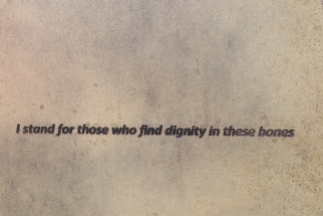Date Of Visit: October 7, 2017
Location: 386 State St, Portsmouth, NH
Hours: open daily, 24 hours a day
Cost: Free
Parking: There is not a parking lot for the memorial but there is limited metered parking on State St (free before 8 a.m.)
Handicapped Accessible: Yes
Dog Friendly: Yes
Website: African Burying Ground Memorial Park
Highlights: sculptures, memorial, historical
Tips:
- street parking is free before 8 a.m.
- the entrance to the park is on State St, although it is often listed as Chestnut St.
- don’t forget to read the signs placed throughout the memorial for more background information about the memorials
It’s not common knowledge, or it’s a conveniently forgotten fact, that Africans and other people were brought to the northern states as slaves. It was not just something that plagued the south.
The first known slave that was sent to Portsmouth was a man from Guinea who was brought there in 1645. He was not the only either. Soon, hundreds of other slaves would follow. In fact, during the Colonial Era, Portsmouth had the largest number of slaves in the colony. Up to 4 percent of the population of the town were slaves, according to a 1767 census. By 1810, there were virtually no slaves in the area. However, rumors of the “Negro Burying Yard” persisted.
The site, referenced in town records as, “the Negro Burying Yard” was paved over, built upon and dismissed. That is, until 2015.
Years and years passed with these bodies buried unceremoniously in an unmarked gravesite until a work crew excavating the area found wooden coffins with human remains buried under the pavement. DNA analysis and other tests confirmed the individuals exhumed as being African. In 2008, 8 bodies and coffins were dug up in the area. There were roughly 200 bodies buried there. After much debate, the town decided to re-inter the bodies in their original resting place. In 2015, the remains were buried and the memorial was built and dedicated to them.
At the entrance to the park there is a memorial of two people on a slab facing opposite directions. This was meant to embody the separation and uncertainty experienced by those brought here as captives as well as their perserverance. The gap between their fingertips is meant to be a reminder of their forced separation and the divisions of past injustice.

The sculptures of the people are called The Entry Figures. The male figure in the group stands for the first enslaved Africans that were brought to Portsmouth and those that followed.

The woman on the other side of the represents Mother Africa. She is endlessly straining past the obstacles that keep her from her children of the Diaspora.

The pain etched on their faces is undeniable.
As you enter the park, you may notice words etched on the ground. These words are the “petition line.” The petition line is a collection of phrases from the Freedom Petition that 20 men who were purchased as slaves had filed with the New Hampshire legislature to gain their freedom. (see video below to see the Petition Line).
Roughly in the middle of the park is a design under which the burial vault is located. The Adinkra Figure “Sankofa” meaning “Return and Get It – Learn From The Past” forms a shield and cover for the burial vault. The re-interred bodies rest beneath this this shield never to be disturbed again.

The life-sized bronze silhouettes, known as the “community figures”, represent the collective community of Portsmouth. They are meant to symbolize the people who fought to acknowledge, pay tribute to and defend the souls whose remains were recovered there. Each of the figures has a line from a poem by the memorial’s designer and sculptor, Jerome Meadows.
Encircling the figures on the railing are designs based on African kente cloth motif. The shapes of the designs are meant to represent boat paddles. The ceramic tiles were created by students from the Portsmouth Public Schools. Having the children of the area create these decorative tiles was meant to be a gesture to those buried there. The younger generation were able to contribute to the memorial and possibly, in some small way, pay tribute to the people buried there. One of the videos below shows the tiles in their entirety.
The park is a peaceful place for reflection. I was a relief and heart warming, though, to see children (you may hear them in one of the videos), playing and enjoying their time at the park, unaware of the tragedy that occurred there. I think those buried there would be happy to know others are able to enjoy the park despite the sadness attached to it.
I also think it is important to try to find light and not only learn from these memorials but also find inspiration there.
These videos below show the railing and petition line at the park.


















